#Finlandterritorialseamap
Explore tagged Tumblr posts
Text
Finland claims about straight baselines and outer limits of the territorial sea

a map (provisional) and of a list of geographical coordinates (straight baselines; outer limits of the territorial sea) mzn8Download fin_mzn8_1996Download

The Finnish straight baseline system has been printed on large-scale charts published by the Finnish Hydrographic Office. The most recent editions, which have been examined by this office, were printed in 1965. The law contains three interesting concepts. First, the system is subject to a periodic review. According to Article 4(3), the points must be corrected at intervals of 30 years. Second, the Government of Finland has commenced its straight baseline system by connecting Swedish and Finnish islets; the intersection of this line with the Finnish-Swedish maritime frontier marks the beginning of the Finnish system. This unusual technique has been employed by several North European states. The third, and most important, concept is stated in Article 4(2) which provides that the basepoints will be chosen so that their distance from one another is at most twice the width of the marginal sea…." As a consequence, the longest Finnish straight baseline segment measures 8 nautical miles or less in length, a restriction which contrasts sharply with the practices of many states. The limitation of the length of baseline segment means that the Finnish system nearly duplicates the configuration of the fringing islands. The Finnish system is the least expansive straight baselines yet analyzed by this office. The total length of the Finnish system measures approximately 793.2 nautical miles between the Swedish and Soviet maritime frontiers. The average length of a segment is approximately 4.4 nautical miles. Finland is a party of the Convention on the Territorial Sea and Contiguous zone.

Read the full article
#ActontheDelimitationoftheTerritorialWatersofFinland#Finland#Finlandcontinentalshelfmap#FinlandEEZmap#Finlandmaritimeboundaries#Finlandmaritimeclaims#Finlandstraightbaselines#Finlandterritorialseamap#MaritimeClaims#TheFinnishstraightbaseline#TheFinnishstraightbaselinearoundtheAland̊archipelagoandtheSwedish-Finnishterritorialseas
0 notes
Text
Finland claims about straight baselines and the median line separating the continental shelf and fishery zones of Finland from the continental shelves and exclusive economic zones of Estonia and Sweden
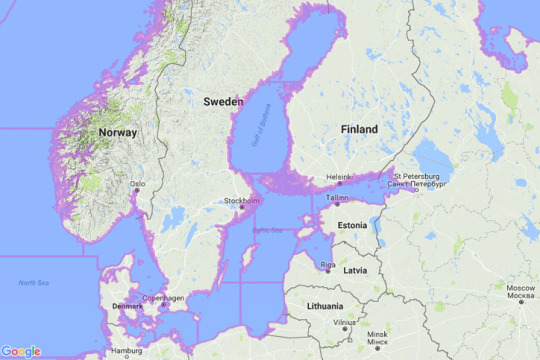
charts showing the straight baselines and the outer limits of the territorial sea of Finland, and the median line separating the continental shelf and fishery zones of Finland from the continental shelves and exclusive economic zones of Estonia and Sweden mzn16Download
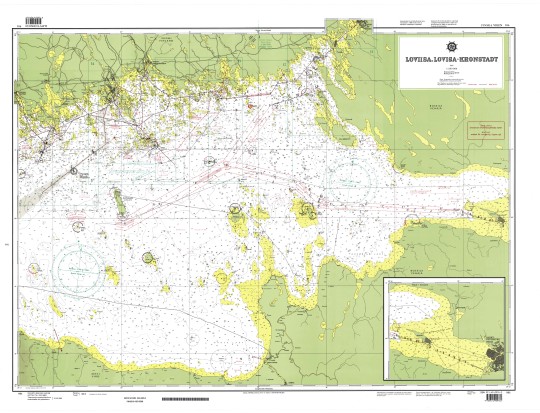
"Loviisa, Lovisa - Kronstadt", Scale 1:200,000 (front)
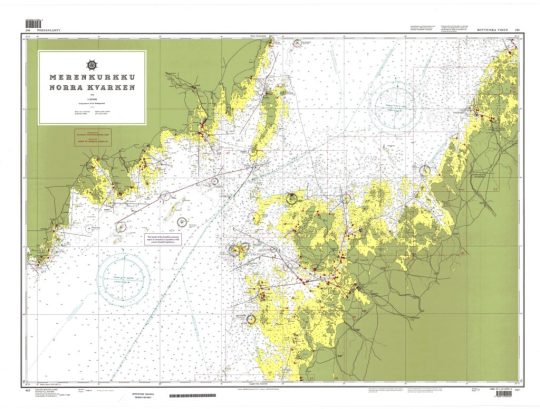

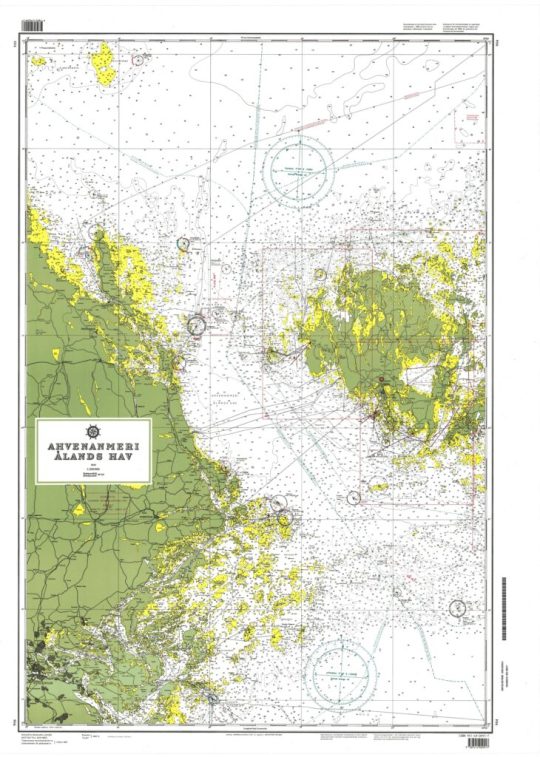
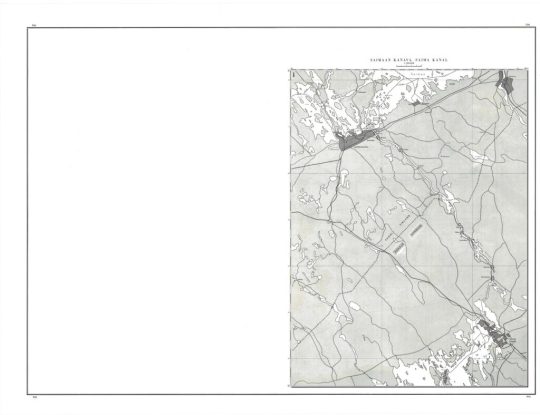

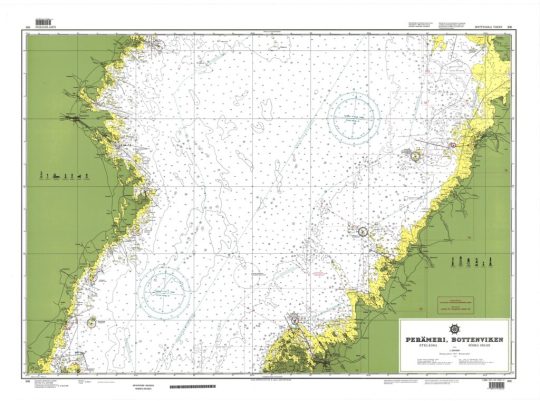
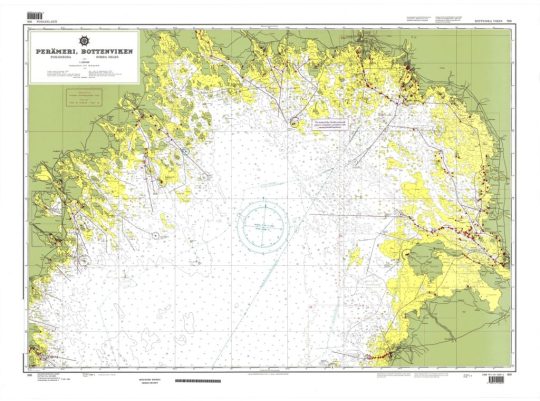
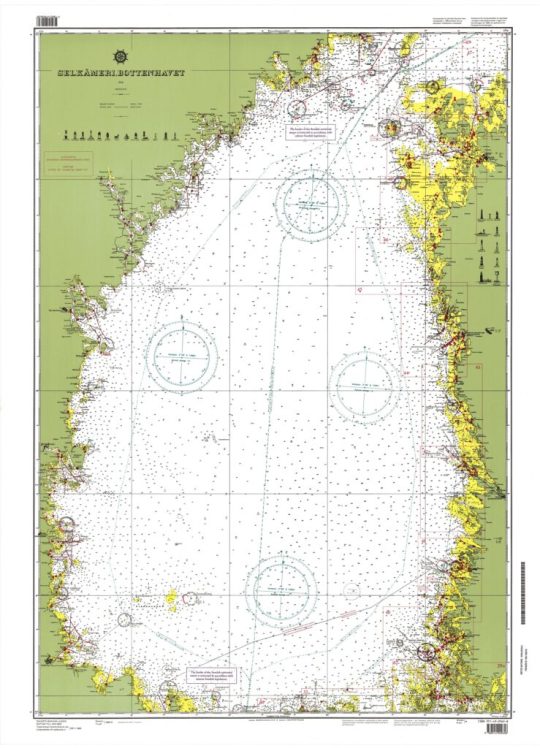
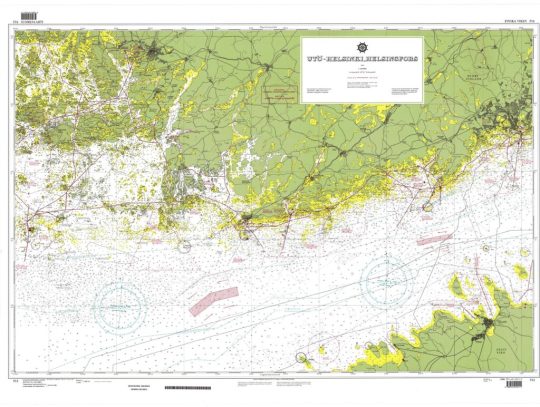
The Finland-Sweden continental shelf agreement is plotted on the attached DMA/HC charts 44030 and 44180. The official Finnish nautical charts cited in Article 6 of the Agreement were used to compute the distances between the boundary points and Finnish straight baselines. Official Swedish charts Nos. 41, 42, 51, 53, and 71 (1:200,000) were used to measure distances to the Swedish baselines. The shelf boundary extends for a distance of approximately 419.76 nautical miles and has 17 turning or terminal points. The boundary runs the entire length of the Gulf of Bothnia, through the narrow Aland Sea, and into the northernmost part of Baltic Sea. As stated in Article 2 of the Agreement, the first point on the boundary is the intersection of Sweden's territorial sea limit (4 nautical miles) with the Finland-Sweden territorial sea lateral boundary. From point 1 to point 2 the shelf boundary coincides with the territorial sea boundary. At point 2 the outer limit of Finland's territorial sea (4 nautical miles) intersects the territorial sea and the shelf boundaries. Both states employ a straight baseline system when delimiting their territorial seas.1 The straight line connecting points 2 and 3 is 130.48 nautical miles in length and constitutes the longest single segment of the boundary. Point 9 represents the intersection of the outer limit of Sweden's territorial sea with the straight line between point 8 and the middle of Market. Sweden's 4-nautical-mile territorial sea is, at this point, measured from Market. The short boundary segment from point 9 to point 10 (0.20 nautical miles) coincides with Sweden's territorial sea. Point 10, according to the Agreement, represents the intersection of Finland's territorial sea limit with the straight line between point 8 and Market. An interesting question arises with regard to Finland's territorial sea limit in the Aland Sea. According to Article II of the Convention on the Non-fortification and Neutralisation of the Aland Islands (signed at Geneva, October 20, 1921), "the territorial sea of the Aland Islands are considered to extend for a distance of three nautical miles from the low-water mark in the islands, islets, and reefs not permanently submerged." In Article 1 of Decree No. 643 of August 18, 1956, establishing Finland's straight baselines system, reference is made to the 1921 Convention regarding the territorial sea limit in the Aland Sea. Yet, on the official Finnish charts Finland's territorial sea in this area is shown to be 4 nautical miles and not 3 nautical miles. Article 5 of the Finland-Sweden Agreement states only that "points 8, 13, 15, and 17 referred in Articles 3-4 are identical with the points designated in the Aland Convention of 1921 as points 17, 15, 14, and 13, respectively" (emphasis added). Referring to International Legislation No. 54, p. 747, a slight discrepancy occurs between the above four points of the 1921 Aland Convention with the above four points of the Finland- Sweden Agreement. This discrepancy is probably a result of more accurate, modern surveys. The following is a comparison of the 1921 Convention points with the Finland-Sweden Although Article 1 of the shelf agreement states that the boundary "shall in principle be a median line between the baselines," at no point is the boundary truly equidistant. For a boundary to meet this criterion the entire boundary must be equidistant from two points (one point on each coast or baseline) with the turning points equidistant from three points (two points on one baseline, one point on the other). On this shelf boundary the turning points are not even equidistant from two points. This fact is recognized by both states. Special circumstances are cited in Article 1; these special circumstances consist of using boundary lines fixed partly in 1811 and partly in the 1921 Convention mentioned earlier. The Agreement also states that, "in order that the boundary line may have a practical and suitable extension it shall be made up of straight lines between points in Arts. 2-4." The following table shows the distance from the respective baselines to the boundary and the distance between the boundary turning points.
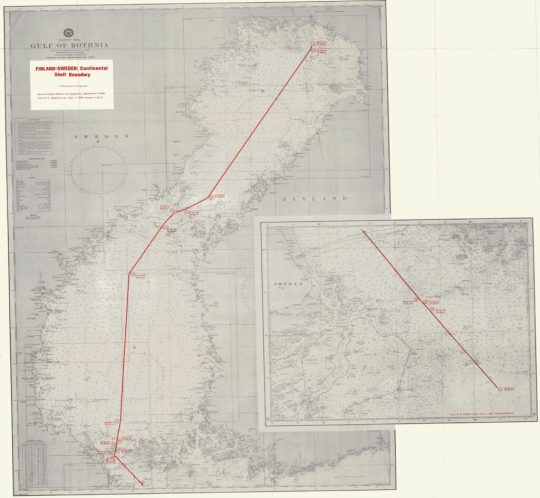
Read the full article
#Estonia#Estoniamaritimeboundaries#Finland#Finlandcontinentalshelfmap#FinlandEEZmap#Finlandmaritimeboundaries#Finlandmaritimeclaims#Finlandstraightbaselines#Finlandterritorialseamap#MaritimeClaims#Sweden#TheGulfofFinland
0 notes
Text
Finland claims about straight baselines and outer limits of the territorial sea

a map (provisional) and of a list of geographical coordinates (straight baselines; outer limits of the territorial sea) mzn8Download fin_mzn8_1996Download The Finnish straight baseline system has been printed on large-scale charts published by the Finnish Hydrographic Office. The most recent editions, which have been examined by this office, were printed in 1965. The law contains three interesting concepts. First, the system is subject to a periodic review. According to Article 4(3), the points must be corrected at intervals of 30 years. Second, the Government of Finland has commenced its straight baseline system by connecting Swedish and Finnish islets; the intersection of this line with the Finnish-Swedish maritime frontier marks the beginning of the Finnish system. This unusual technique has been employed by several North European states. The third, and most important, concept is stated in Article 4(2) which provides that the basepoints will be chosen so that their distance from one another is at most twice the width of the marginal sea…." As a consequence, the longest Finnish straight baseline segment measures 8 nautical miles or less in length, a restriction which contrasts sharply with the practices of many states. The limitation of the length of baseline segment means that the Finnish system nearly duplicates the configuration of the fringing islands. The Finnish system is the least expansive straight baselines yet analyzed by this office. The total length of the Finnish system measures approximately 793.2 nautical miles between the Swedish and Soviet maritime frontiers. The average length of a segment is approximately 4.4 nautical miles. Finland is a party of the Convention on the Territorial Sea and Contiguous zone.

Read the full article
#ActontheDelimitationoftheTerritorialWatersofFinland#Finland#Finlandcontinentalshelfmap#FinlandEEZmap#Finlandmaritimeboundaries#Finlandmaritimeclaims#Finlandstraightbaselines#Finlandterritorialseamap#MaritimeClaims#TheFinnishstraightbaseline#TheFinnishstraightbaselinearoundtheAland̊archipelagoandtheSwedish-Finnishterritorialseas
0 notes
Text
Finland claims about straight baselines and the median line separating the continental shelf and fishery zones of Finland from the continental shelves and exclusive economic zones of Estonia and Sweden

charts showing the straight baselines and the outer limits of the territorial sea of Finland, and the median line separating the continental shelf and fishery zones of Finland from the continental shelves and exclusive economic zones of Estonia and Sweden mzn16Download
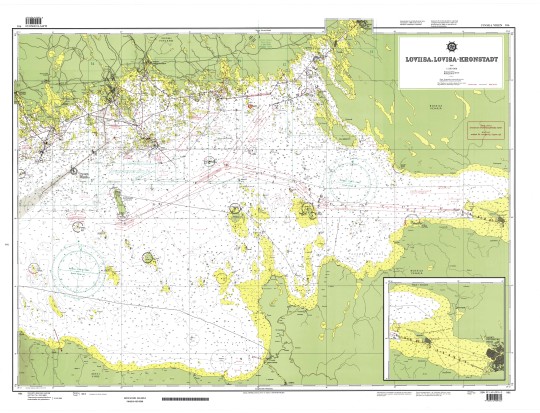
"Loviisa, Lovisa - Kronstadt", Scale 1:200,000 (front)
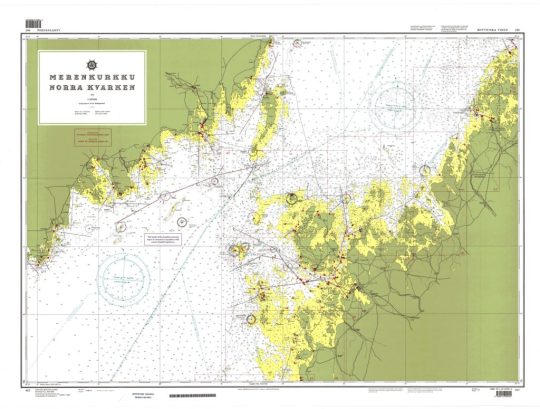
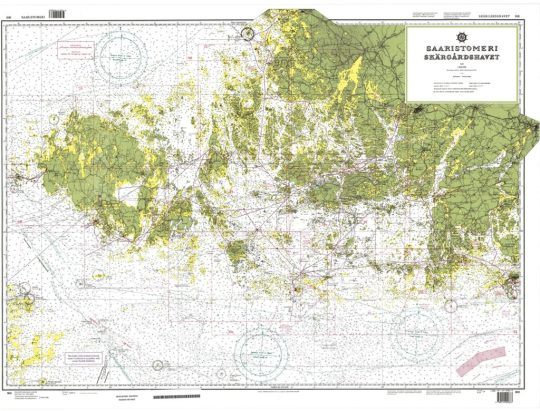
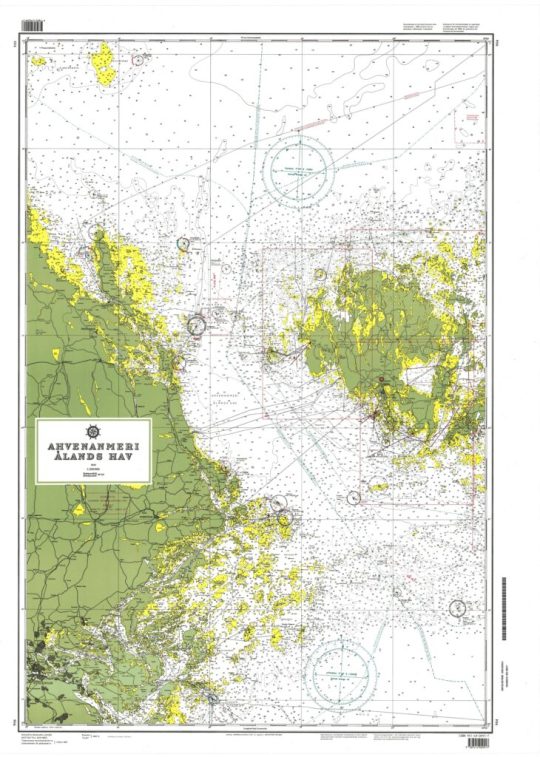
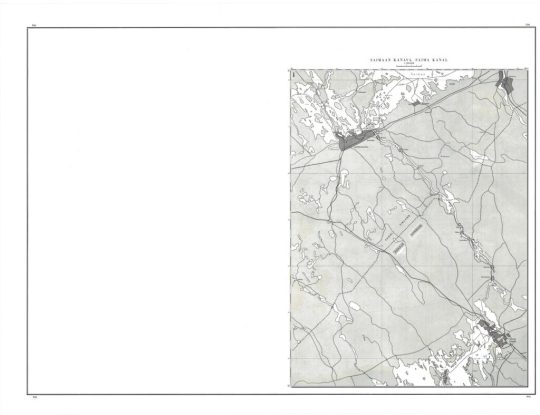
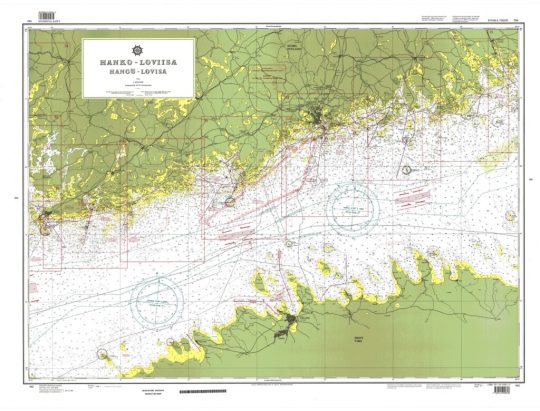
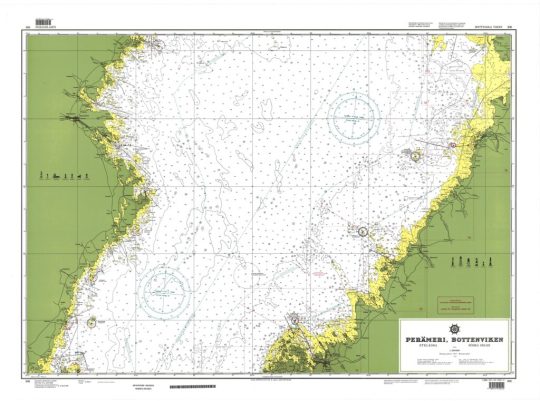

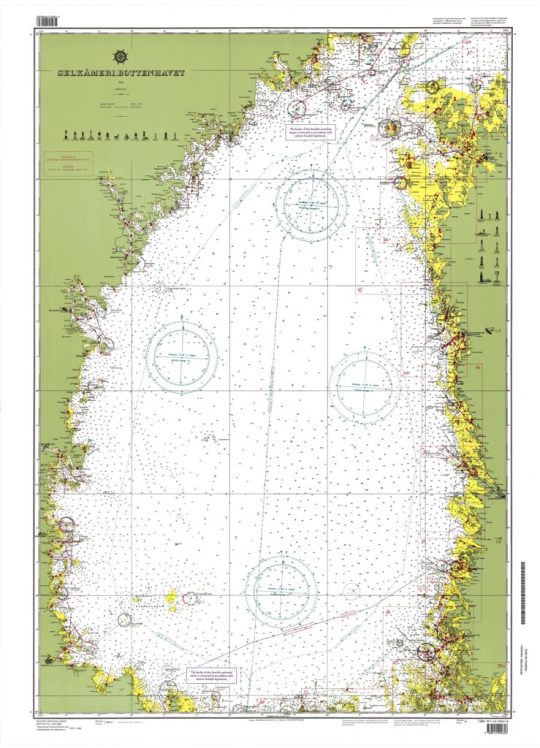
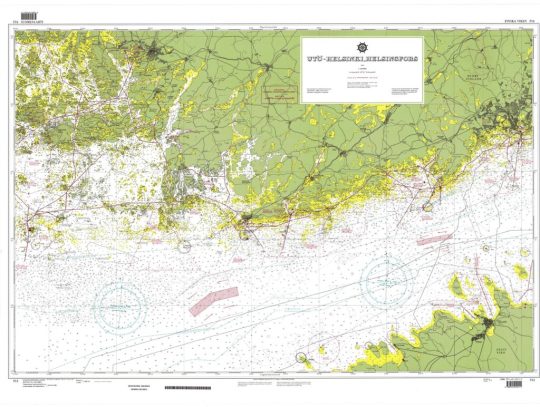
The Finland-Sweden continental shelf agreement is plotted on the attached DMA/HC charts 44030 and 44180. The official Finnish nautical charts cited in Article 6 of the Agreement were used to compute the distances between the boundary points and Finnish straight baselines. Official Swedish charts Nos. 41, 42, 51, 53, and 71 (1:200,000) were used to measure distances to the Swedish baselines. The shelf boundary extends for a distance of approximately 419.76 nautical miles and has 17 turning or terminal points. The boundary runs the entire length of the Gulf of Bothnia, through the narrow Aland Sea, and into the northernmost part of Baltic Sea. As stated in Article 2 of the Agreement, the first point on the boundary is the intersection of Sweden's territorial sea limit (4 nautical miles) with the Finland-Sweden territorial sea lateral boundary. From point 1 to point 2 the shelf boundary coincides with the territorial sea boundary. At point 2 the outer limit of Finland's territorial sea (4 nautical miles) intersects the territorial sea and the shelf boundaries. Both states employ a straight baseline system when delimiting their territorial seas.1 The straight line connecting points 2 and 3 is 130.48 nautical miles in length and constitutes the longest single segment of the boundary. Point 9 represents the intersection of the outer limit of Sweden's territorial sea with the straight line between point 8 and the middle of Market. Sweden's 4-nautical-mile territorial sea is, at this point, measured from Market. The short boundary segment from point 9 to point 10 (0.20 nautical miles) coincides with Sweden's territorial sea. Point 10, according to the Agreement, represents the intersection of Finland's territorial sea limit with the straight line between point 8 and Market. An interesting question arises with regard to Finland's territorial sea limit in the Aland Sea. According to Article II of the Convention on the Non-fortification and Neutralisation of the Aland Islands (signed at Geneva, October 20, 1921), "the territorial sea of the Aland Islands are considered to extend for a distance of three nautical miles from the low-water mark in the islands, islets, and reefs not permanently submerged." In Article 1 of Decree No. 643 of August 18, 1956, establishing Finland's straight baselines system, reference is made to the 1921 Convention regarding the territorial sea limit in the Aland Sea. Yet, on the official Finnish charts Finland's territorial sea in this area is shown to be 4 nautical miles and not 3 nautical miles. Article 5 of the Finland-Sweden Agreement states only that "points 8, 13, 15, and 17 referred in Articles 3-4 are identical with the points designated in the Aland Convention of 1921 as points 17, 15, 14, and 13, respectively" (emphasis added). Referring to International Legislation No. 54, p. 747, a slight discrepancy occurs between the above four points of the 1921 Aland Convention with the above four points of the Finland- Sweden Agreement. This discrepancy is probably a result of more accurate, modern surveys. The following is a comparison of the 1921 Convention points with the Finland-Sweden Although Article 1 of the shelf agreement states that the boundary "shall in principle be a median line between the baselines," at no point is the boundary truly equidistant. For a boundary to meet this criterion the entire boundary must be equidistant from two points (one point on each coast or baseline) with the turning points equidistant from three points (two points on one baseline, one point on the other). On this shelf boundary the turning points are not even equidistant from two points. This fact is recognized by both states. Special circumstances are cited in Article 1; these special circumstances consist of using boundary lines fixed partly in 1811 and partly in the 1921 Convention mentioned earlier. The Agreement also states that, "in order that the boundary line may have a practical and suitable extension it shall be made up of straight lines between points in Arts. 2-4." The following table shows the distance from the respective baselines to the boundary and the distance between the boundary turning points.
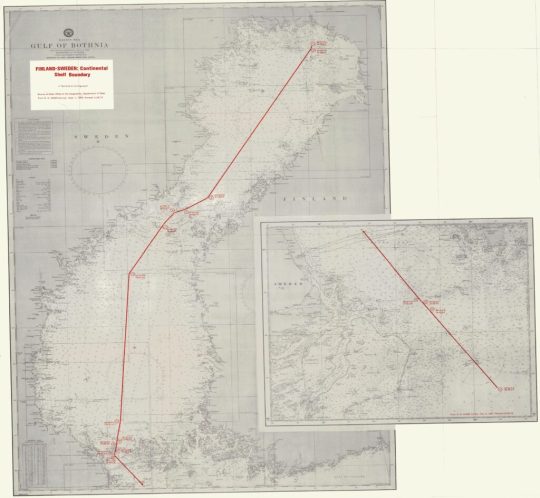
Read the full article
#Estonia#Estoniamaritimeboundaries#Finland#Finlandcontinentalshelfmap#FinlandEEZmap#Finlandmaritimeboundaries#Finlandmaritimeclaims#Finlandstraightbaselines#Finlandterritorialseamap#MaritimeClaims#Sweden#TheGulfofFinland
0 notes
Text
maritime boundaries between Finland and Estonia

Agreement between the Republic of Estonia and the Republic of Finland on the Boundary of the Maritime Zones in the Gulf of Finland and the Northern Baltic Sea was signed in 18 October 1996. In principle, the main aim of the negotiations was not to try to establish a maritime boundary in areas· where no such boundary existed before. In fact, only a very minor part of this agreement could fit such a description. What the Estonia-Finland Agreement did rather was to provide an answer to the much more subtle question about the ·exact legal value to be attributed under international law to the previously concluded maritime boundary agreements, in casu by the former Soviet Union. For several years the parties side-Stepped the crux of the issue on a provisional basis. Indeed, in 1992 Estonia and Finland started out by concluding an interim agreement. Since no final agreement had yet been reached between the parties at the end of this first period, the latter was extended for another two years. It was clearly stressed that the agreements themselves had not entered into force between the parties, but that the latter had only agreed that the content of these agreements would be applied ad interim. Both countries now have recently terminated the interim agreement by concluding a definite agreement on the subject. The final outcome seems to indicate that the whole operation can be characterized as a storm in a teacup. Out of the 17 points listed in the agreement, 16 correspond to turning points already established by the former Soviet Union in its relations with Finland. Only the last point is totally new. But this .segment of the line is special, for it covers a maritime area in which the former Soviet Union and Finland had never been able to arrive at a delimitation. In other words, in as far as a maritime boundary line existed at the time of the dissolution of the Soviet Union, that line has now been taken over, point by point, by Estonia and Finland to form the basis of the new agreement. The only real novelty introduced by the Estonia-Finland Agreement therefore concerns the last point listed in Article 2. This turning point touches upon the most difficult problem of the exact effect to be attributed to the Bogskar island group belonging to Finland. The latter, which consis1s primarily of two uninhabited rocks with a total area of approximately 4-5 sq. km., is located close to the hypothetical tri-junction point with Sweden. In its relationship with Sweden, Finland had just arrived at a political compromise in this respect. The present agreement allowed the parties to close the remaining gap around this trijunction somewhat further from the east. Totally in line with a well-established practice in the Baltic Sea, the .agreement finally leaves the two tri-junction points open for later determination with the interested parties. it is notable the that Nevertheless, all three Baltic States have moved towards accepting the maritime boundaries negotiated on their behalf by the Soviet Union with Finland and Sweden, often through negotiating fresh agreements which serve to reconfirm the course of the relevant maritime boundaries. A good example of this trend is Estonia’s interim 1992 agreement with Finland on the provisional application of certain treaties concluded between Finland and the former Soviet Union. The 1992 agreement did not confirm the validity of the Soviet-era treaties. Instead, Estonia and Finland simply agreed to observe their provisions for practical reasons for a specified period of time. Among the treaties covered by the 1992 agreement, which was extended for an additional two years in January 1995, were four maritime boundary accords between Finland and the former USSR. Whilst the 1992 agreement was in effect Estonia and Finland were able to conduct maritime boundary delimitation negotiations leading to the conclusion of a new delimitation treaty on 18 October 1996. The turning points defined in the 1996 agreement are directly based on those previously agreed between Finland and the former Soviet Union, aside from a 30 nm long western extension of the maritime boundary. In keeping with other Baltic sea maritime boundary agreements, the treaty notes, in Article 2, that ‘the starting point of the boundary is that point in the east on which agreement will be reached with the third State concerned’ – that third state being the Russian Federation. Estonia’s unilateral definition of its territorial sea and EEZ does include qualifying ‘remarks’, however. In respect of Estonia’s territorial sea claim within the Bay of Narva it is noted that as this has not been determined in negotiations with Russia, the boundary ‘may change as a result of these negotiations’. It is similarly stated in relation to the boundary of Estonia’s continental shelf and EEZ ‘near Vaindlo Island in the Gulf of Finland’, that as the boundary has not been determined in negotiations with the Russian Federation, the boundary ‘may change as a result of the negotiations’. Once the starting point for the maritime boundary on the coast is determined, the maritime delimitation should not prove particularly problematic. An equidistance line between the parties coasts extends for approximately 65 nm in length initially westwards through the Bay of Narva before turning northwestwards towards the centre of the Gulf of Finland and the potential tripoint with Finland between the Russian island and rock of Ostrov Malyy Tyuters and Ostrov Rodsher and the Estonia islet of Vaindloo Saar. Although relatively small islands or rocks are involved in defining the seaward part of the delimitation, it is unlikely that it could be argued by either side that these should be discounted given that the delimitation predominantly concerns the territorial sea. Furthermore, a delimitation based on equidistance relies on islands and rocks as basepoints on both sides of the line, which therefore tend to balance one another out. Agreement between the Republic of Finland and the Republic of Estonia on the Boundary of the Maritime Zones in the Gulf of Finland and on the Northern Baltic Sea, 18 October 1996+mapDownload Agreement between the Republic of Finland and the Republic of Estonia on the Boundary of the Maritime Zones in the Gulf of Finland and on the Northern Baltic Sea, 18 October 1996Download

Estonia Straight baseline-internal waters-territorial waters

Finnish Exclusive Economic Zone

Finland Stright baseline-internal waters-territorial waters

Estonia Exclusive Economic Zone






Read the full article
#BayofNarva#Estonia#Estoniacontinentalshelfmap#EstoniaEEZmap#Estoniaexclusiveeconomiczonemap#Estoniainternalwatersmap#Estoniamaritimeboundaries#Estoniamaritimezone#Estoniaterritorialwatersmap#Finland#Finlandcontinentalshelfmap#FinlandEEZmap#Finlandfisheryzonesmap#Finlandinternalwatersmap#Finlandmaritimeboundaries#Finlandmaritimeclaims#Finlandstraightbaselines#Finlandterritorialseamap#VaindloIsland
0 notes
Text
maritime boundaries between Finland and Russia
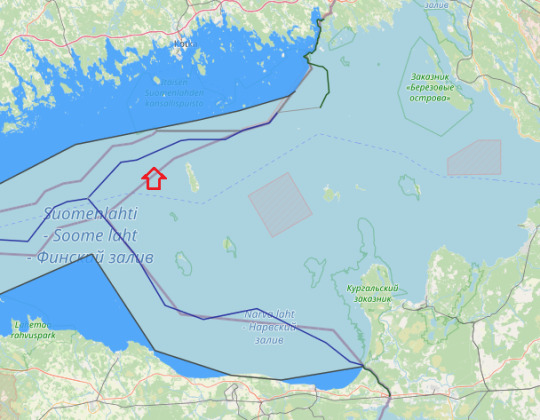
between Russia and Finland, the boundary is on the shore of Gulf of Finland, in which there is a maritime boundary between the respective territorial waters, terminating in a narrow strip of international waters between Finnish and Estonian territorial waters. In 2014, Estonia and the Russian Federation signed their land and maritime boundary agreements that are currently awaiting ratification. This study reconstructs the maritime boundary delimitation between the two States. In particular, the role of islands and pre-existing agreements for the delimitation of the territorial sea boundary in the south-eastern part of the Gulf of Finland are critically examined. It is established that the agreed maritime boundary line is a median line which was influenced by the use of the special circumstances method in the delimitation process. in relation to the first part of the Finland-USSR maritime boundary, military, strategic and related navigational considerations have had a powerful influence on the course of maritime boundaries and it had not based on equidistance method alone. In the modern period maritime delimitation was, at least initially, conducted among the communist states, together with Finland. However, from the early 1970s, and particularly in the wake of the conclusion of the Treaty on the Basis of Intra-German Relations between the two Germanys, a number of agreements were concluded between Western and Soviet bloc states, despite the profound ideological and economic divides between the littoral states. This remarkable situation has been attributed, not only to small size (the average width being about 120 miles) and semi-enclosed characteristics of the Baltic but to its shallowness (average depth being 55 m), the large number of rivers flowing into it, high coastal populations and a high degree of industrialization among the littoral states. This combination of factors dictated a clear need for cooperation’. considered chronologically, maritime boundaries in the Baltic Sea have therefore been concluded between Denmark and Germany (1965 and 1988), Finland and the USSR (1965, 1967, 1980 and 1985) and more.. Finland was the first, in 1956, when it placed the termini of its model straight baselines in the sea to link with subsequent baselines drawn by Sweden and Russia. Finland For most of length straight baselines cross water but their termini are on land and are defined by the coordinates on or near the normal baseline. It would be prudent for countries to review the coordinates defining their straight baselines at set intervals. This would ensure that any changes in the configuration of the low-water line can be recorded and the coordinates of basepoints adjusted. Finland seems to be the only country that specified in its declaration of its straight baselines that they would be reviewed every 30 years. in 1995 Finland reviewed the 1965 definition of its baselines. Finland took the opportunity to abandon its requirement that no segment of its baselines should be longer than 8 nm. The length of baselines in the previous system averaged 4.4 nm. The previous system ensured that the Finnish straight baselines conformed to the coast to a greater degree than those of any other country. The new arrangements allow the Finns to use fewer basepoints which will reduce the costs of future measurements. The 1995 definition will cover the period 1995-2024. Agreement between the Government of the Republic of Finland and the Government of the Union of Soviet Socialist Republics concerning the boundaries of sea areas and of the continental shelf in the Gulf of Finland, 20 May 1965Download Agreement between the Government of the Republic of Finland and the Government of the Union of Soviet Socialist Republics concerning the boundary of the continental shelf between Finland and the Soviet Union in the north-eastern part of the Baltic Sea, 5 May 1967 (entry into force: 15 March 1968)Download Agreement between the Government of the Republic of Finland and the Government of the Union of Soviet Socialist Republics regarding the delimitation of the areas of Finnish and Soviet jurisdiction in the field of fishing in the Gulf of Finland and the North-eastern Part of the Baltic Sea, 25 February 1980 (entry into force: 9 July 1980)Download Agreement between the Government of the Republic of Finland and the Government of the Union of Soviet Socialist Republics regarding the delimitation of the economic zone, the fishing zone and the continental shelf in the gulf of Finland and in the North-Eastern part of the Baltic Sea, 5 February 1985 (entry into force: 24 November 1986)Download

Russia Straight baseline-internal waters-territorial waters in gulf of Finland
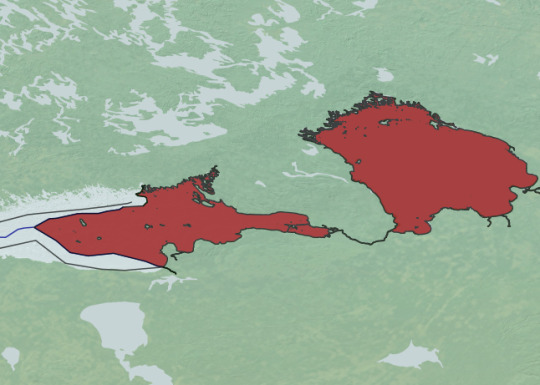
Russian Exclusive economic Zone in gulf of Finland
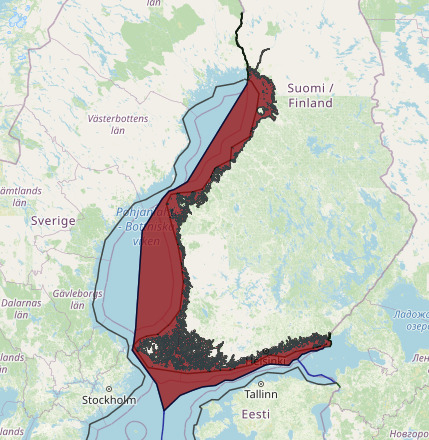
Finnish Exclusive Economic Zone
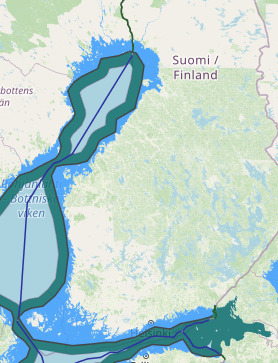
Finland Stright baseline-internal waters-territorial waters
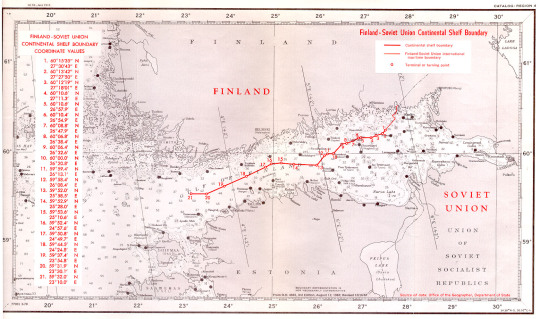
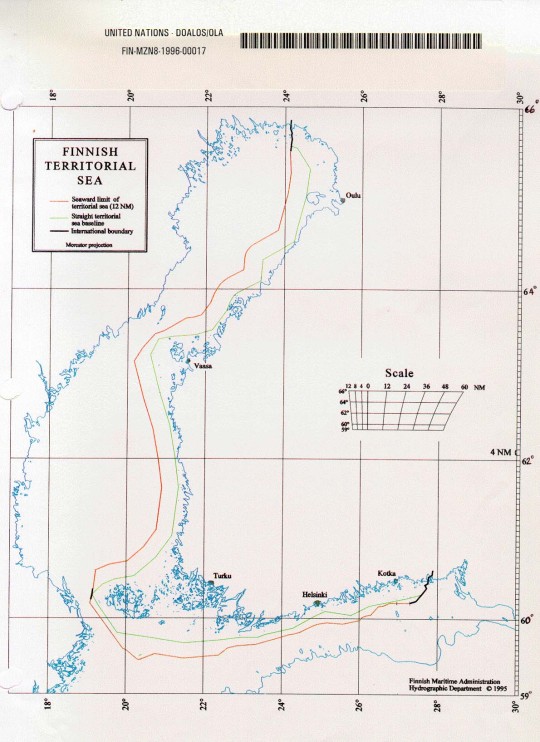
map (provisional) and of a list of geographical coordinates (straight baselines; outer limits of the territorial sea) of Finland
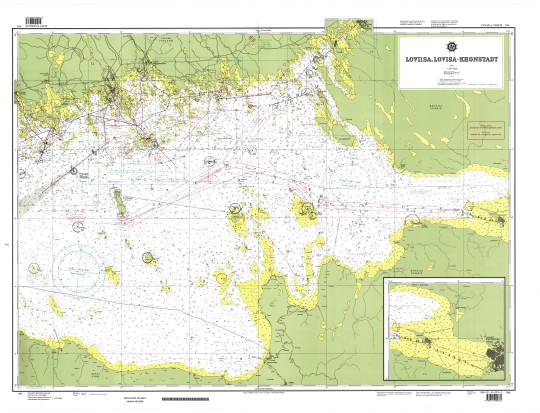
"Loviisa, Lovisa - Kronstadt", Scale 1:200,000
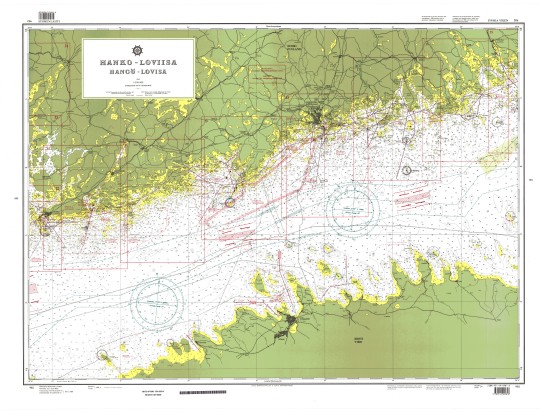
"Hanko-Loviisa/Hangö-Lovisa", Scale 1:200,000 Read the full article
#Finland#Finlandcontinentalshelfmap#FinlandEEZmap#Finlandfisheryzonesmap#Finlandinternalwatersmap#Finlandmaritimeboundaries#Finlandmaritimeclaims#Finlandstraightbaselines#Finlandterritorialseamap#russia#Russiacontinentalshelfmap#Russiaexclusiveeconomiczonemap#Russiainternalwatersmap#Russiamaritimeboundaries#Russiamaritimeclaims#Russiaterritorialwatersmap#russianfederation#TheGulfofFinland
0 notes